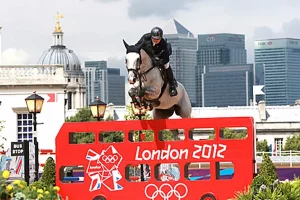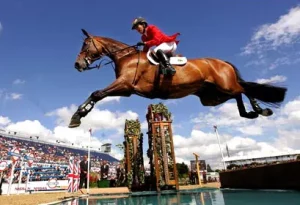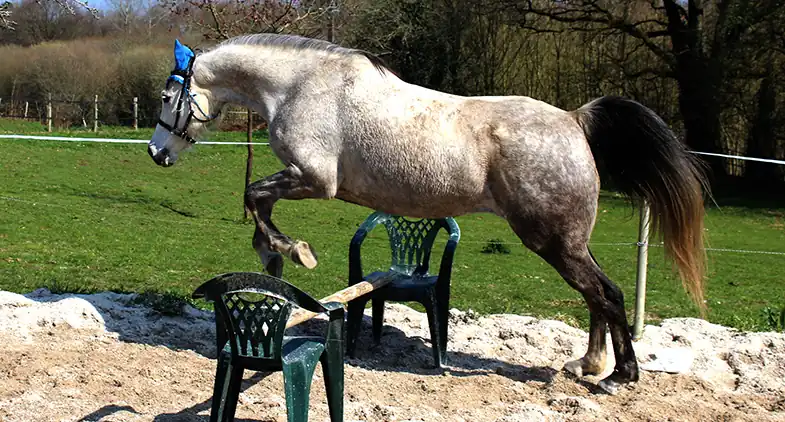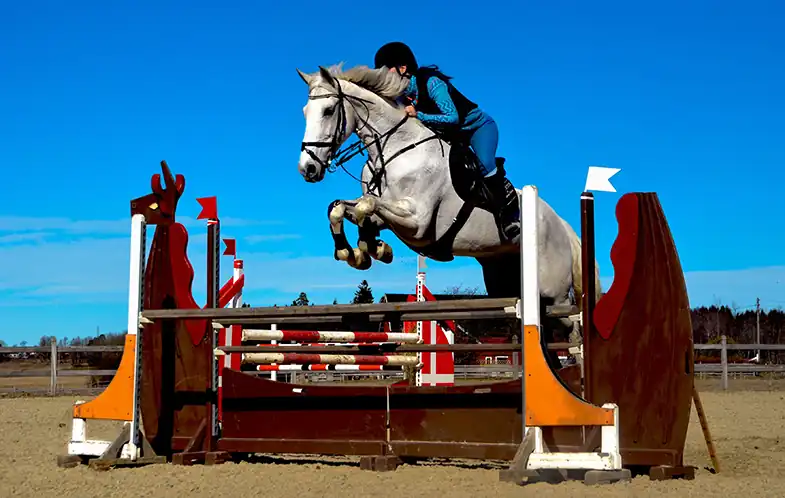You might be surprised to know that all horses are born with the ability to jump, a skill that would have drastically increased their chances of survival in the past. After all, if you’re being chased by a tiger and could jump over an obstacle you stood a better chance of surviving than an animal that couldn’t.
While horses obviously don’t need to worry about this anymore their jumping ability is something that has never left them, but just how well can a horse actually jump? This is something that I’ve often wondered about so decided to find out.
How high can a horse jump? Without any training, the average horse can jump somewhere between 2.5ft and 3ft (0.76m and 0.91m), but top-level jumpers can easily clear a 7ft (2.1m) fence. The Guinness World Record for the highest jump by a horse stands at a mind-blowing 8ft 1.25in (2.47m).
How high can the average horse jump?
There is a general consensus that most horses can only jump as high as their withers, but while this is quite feasibly true of the ‘average’ horse it certainly won’t be true for all of them. After all, I don’t think that a Shire Horse could jump over a 5ft (1.52m) obstacle even if it wanted to.
This is where the 2.5ft (0.76m) to 3ft (0.91m) average comes into play but this is only true of untrained horses with a rider on their backs or while being lunged. If a horse has been spooked by something, is bored, or just wants to get out of his field (for whatever reason), then he can quite easily clear a 4.5ft (1.37m) perimeter fence.
How high can an Olympic horse jump?
Most horses haven’t been bred specifically for jumping, nor have they been trained to jump properly which is why fences at novice level competition are always lower than 3ft (0.91m). When it comes to competition horses though, not only have they been selectively bred for jumping but they’ve also had many years of training before they ever make it onto the international scene.
With this in mind Olympic fences (along with all other top-level fences) are designed to push the horse and rider and to test their ability to jump fences at speed. The jumps will test both the height with which they can jump as well as how far, but due to the speed factor fences are limited to a maximum height of 5ft 3in (1.6m). Their width is also fixed but maximum width is determined by the type of jump, for example, a standard jump will be no more than 6ft 7in (2m) while triple fences will be a maximum of 7ft 2in (2.2m) and water jumps should be no wider than 14ft 8in (4.5m).
What height are horse jumps?
The height of horse jumps depends on a number of factors such as the discipline, level of competition, and whether or not it’s an international event. Most countries have their own associations (such as the USEF in the US and the BSJA in the UK) which will set the limits for fences but when it comes to international events the FEI set their own limits.
For Grand Prix events (such as the Olympics and the World Equestrian Games), the FEI rules say that fences should be a maximum of 5ft 3in (1.6m) in height and 6ft 7in (2m) wide. They also say that triples should be no wider than 7ft 2in (2.2m) and water jumps should be a maximum of 14ft 8in (4.5m) wide. The rules also stipulate that there should be between 10 and 16 obstacles in total.
When it comes to horse racing though the fences are normally slightly lower and are built with conifer brush instead of poles (this is because the horses jump through rather than over them). The biggest steeplechase fence though, known as The Chair, is a Grand National fence that’s 6ft (1.8m) high but with a 5ft 2in (1.58m) ditch.
How far can a horse jump?
When we talk about horses jumping we’re usually referring to how high they can jump and when you look at any showjumping event it’s easy to understand why, but one thing that has often intrigued me is just how far forward they can jump.
As a rough guide horses can jump approximately three times their length which, when you consider the average horse is 7ft 9in (2.4m) is an incredible 23ft 6in (7.2m). Even with training, horses aren’t able to jump more than three and a half times their body length. This was proved in April 1975 when a horse known as Something set the world record for the longest water jump by a horse. Along with his rider, Andre Ferreira, Something managed to jump a groundbreaking 24ft (8.4m). [source]
Record breaking horse jumps
Even without any training horses are capable of jumping pretty well but when you’ve got the perfect cocktail of horse breeding and training the sky is pretty much the limit as you can see below.
| Record | Horse | Rider | Height ft / meters | When |
|---|---|---|---|---|
| Highest jump | Huaso Ex-Faithful | Alberto Morales | 8ft 1.25in / 2.47m | Feb 1949 |
| Highest jump (unofficial) | King’s Own | Freddy Wettach | 8ft 3in / 2.53m | 1927 |
| World puissance | Optiebeurs Golo | Franke Sloothaak | 7ft 10.5in / 2.40m | Jun 1991 |
| World bareback puissance | Waterstone | Robert Whitaker | 6ft 9.5in / 2.12m | Nov 2011 |
| Highest side saddle jump | Seic Atlas | Susan Oakes | 6ft 8in / 2.07m | Oct 2013 |
| Longest jump | Something | Andre Ferreira | 24ft / 8.4m (distance) | Apr 1975 |
Do horses actually like to jump?
I’m often asked whether or not horses actually enjoy jumping and while horses generally won’t do something they really don’t want to the answer isn’t quite as simple as that. In the wild horses learned to jump as a way of surviving and avoiding predators but that doesn’t mean to say that they only ever jump out of fear.
While there is no doubt horses evolved to jump purely as a way of surviving but that doesn’t mean to say they don’t enjoy it though. There are many horses who will choose to jump on their own (without a rider or handler asking them to) so it stands to reason that they must like jumping.
Some people will argue though that horses only jump because they’re forced to but this is completely untrue. Yes, of course, there will always be riders who force their horses to do things but in the vast majority of cases horses jump because they want to and because they trust their rider won’t let them come to any harm.
Is jumping bad for horses?
While horses have a natural ability to jump that doesn’t mean to say it won’t affect them physically, after all, we can run but it can also sometimes have a detrimental effect on our bodies and the same can be said for horses.
I’m not saying that jumping will always hurt the horse, but more that it has the ability to do so. The reason for this is the sheer weight of the horse combined with the power of their jump and the hardness of the ground. For example, if an Irish Draught is regularly jumping 3ft (0.91m) fences on sandy ground it’s unlikely to impact them as much as jumping 6ft (1.8m) every other day on firm ground would. With this in mind, it’s safe to say that the bigger the jump the higher the risk of injury.
Injuries to the tendons and ligaments that support the horse’s legs (both front and back) are the most common but there are things that you can do to reduce that risk a little. Things such as not jumping too often, giving the horse plenty of rest, and trying to avoid jumping on hard ground as much as possible will all help. Wearing protective boots will also help to support the legs and minimize any potential injury the horse might suffer if they hit a fence.
What makes horses good at jumping?
There is a certain degree of X factor in all of the best jumpers but that is only a small fraction of what makes them so good. Training is probably the most important criteria but breeding comes in a very close second. The reason I say training is more important than breeding is in part due to a famous Grade Horse known as Snowman. Having been saved from slaughter, Snowman went on to have an illustrious jumping career and has now been immortalized in the United States Show Jumping Hall of Fame. [source]
The ideal jumper should have the ability to get their body into the air while also being careful and courageous. They need to be careful to not touch the fence at all, something that can make the difference between a good jumper and a great one. After all, if the horse jumps 8ft (2.4m) but touches the fence they won’t have cleared it.
How do horses actually jump?
In order to be able to jump a fence, a horse needs to transfer a lot of energy to his hips, knees, fetlocks, and ankles. This energy gives him a spring like ability to propel himself (and the rider) over the obstacle in front of him. The fence is then cleared (hopefully) in a forwards and horizontal motion that’s played out in five phases.
- Approach – This will decide if the horse will attempt to jump the fence or not, if the horse or rider approach the fence wrongly then the horse may stop or refuse to jump altogether.
- Take off – Using their hindquarters, the horse will spring from the rear and propel themselves forward. Once the horse is in the air they’re no longer able to make any alterations to their position.
- Bascule (or arc in motion) – This is the time when the horse has already left the ground and begins to move up and over the jump in an arcing movement.
- Landing – The horse will land with one foreleg first which is then immediately followed by the other. At the moment the horse ‘impacts’ the ground their muscles and tendons absorb the shock.
- Recovery – This is the last phase when the horse finally has all four feet on the ground and then continues it’s normal stride.
Further reading
- The best breeds for jumping
- Horse jumps explained
- Show jumping vs barrel racing
- The best breeds for eventing
- Is horse riding dangerous?
- Why broken legs so serious
- Is English or Western better?
- The ultimate guide to riding gloves
- The world’s most unusual sports
- Improve your horse’s suppleness
I hope you found this article helpful. If you did I’d be grateful if you could share it please as it would really help me.
Recommended products
Over the years I have tried hundreds of different horsey products, from various blankets and halters to different treats. Some I’ve loved, others I’ve hated but I thought I’d share with you my top all-time favorite products, the ones I never leave the yard without. I’ve included links to the products (which are in no particular order) that I really think are great.
- Horse Knots by Reference Ready – If you’re like me and enjoy pocket reference guides then you’ll love this knot tying guide. These handy cards can easily fit in your pocket or attach to the saddle for quick reference. They’re waterproof, durable and are color coded to make them easy to follow.
- Mane ’n Tail Detangler – Even if you never show your horse you’ll need to detangle his tail from time to time (and possibly his mane too) which is always a challenging chore! I’ve found that if I run a little bit of detangler through my horse’s tails every few days it stops them from getting matted up and makes combing them easy, even if they’re coated in mud. I don’t know if I should admit to this or not but it also works wonders on my hair.
- TAKEKIT Pro clippers – Over the years I’ve tried a lot of different clippers and while some were obviously better than others I found these to be by far the best. They are heavier than a lot of other clippers but for me, that’s a good thing, it makes them feel more sturdy and hardwearing. On top of that they have a range of speeds so are just as good for clipping your horse’s back as they are his face. I also like the fact that they come in a handy carry case but that’s not for everybody. The company that makes them is super good and incredibly helpful too, a real bonus these days. The only thing I wasn’t keen on was the fact that it doesn’t come with any oil, but that’s not a major problem as it’s not difficult to buy lubricant.
- Shire’s ball feeder – There are so many boredom buster toys out there but I like to use these every day, regardless of whether or not my horses are bored. I find that it helps to encourage my horses to problem solve by rewarding them with treats (or pieces of fruit) but it also mimics their natural grazing behavior which helps to keep them calm and de-stressed.
- Horse safe mirror – This is a strange one that many people are surprised about but I like to put horse safe mirrors in the trailers as well as in the quarantine stalls. It helps to prevent the feeling of isolation by giving the impression of other horses being around. Being herd animals horses can get extremely stressed when they feel that they’re on their own but with these stick-on mirrors, they believe that at least one other horse is with them.
- Rectal thermometer – I know this isn’t glamourous at all but it’s vital for your horse’s well-being to be able to check their temperature and a rectal thermometer is the easiest way of doing this which is why I’ve added it to the list.
Shopping lists
I’ve also put together a few shopping lists of essential items that I’ve found helpful over the years. I’ve broken the lists down into different categories rather than put everything in one massive list 😉




